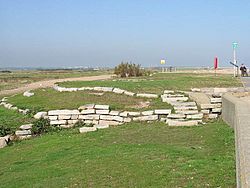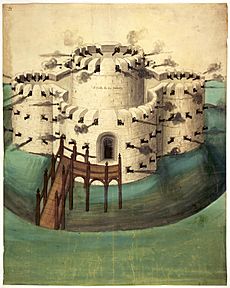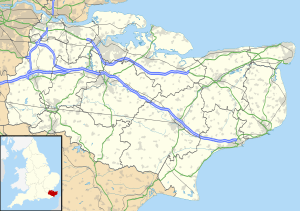Sandown Castle, Kent facts for kids
Quick facts for kids Sandown Castle |
|
|---|---|
| Sandown, Kent, England | |
 |
|
| Coordinates | 51°14′18″N 1°24′08″E / 51.2384°N 1.4022°E |
| Type | Device Fort |
| Site information | |
| Open to the public |
Yes |
| Condition | Limited ruins remain |
| Site history | |
| Events | Second English Civil War |
| Official name | Sandown Castle |
| Designated | 30 August 1960 |
| Reference no. | 1005147 |
Sandown Castle was a strong fort built by King Henry VIII in Sandown, Kent, between 1539 and 1540. It was part of a big building plan called the Device programme. This plan aimed to protect England from attacks by France and the Holy Roman Empire. Sandown Castle helped guard an important area of the sea called the Downs anchorage near the English coast.
The castle had a central keep (a main tower) and four round bastions (outward-pointing parts of the wall). It was surrounded by a moat (a ditch filled with water) and covered about half an acre. On its upper levels, it had 39 places for large artillery guns. In the basement, there were 31 gunloops for smaller handguns. Building Sandown, Walmer, and Deal castles together cost the King about £27,092. These three castles were close to each other along the coast and had earth walls connecting them.
The threat of invasion passed, but Sandown Castle played a role in the Second English Civil War (1648–49). During this time, supporters of the King (called Royalists) took control of the castle. It took several months of fighting for the Parliament's forces (called Parliamentarians) to get it back.
By the 1800s, the castle was slowly being damaged by the sea. Even so, it was still used by the military until 1863. The War Office then blew up the upper parts of the castle. More demolition happened in 1882 and 1893, destroying most of the remaining stone. The town of Deal bought the castle's remains for £35 to use them as part of their sea defences. In the late 1980s, the remaining stone was covered in concrete to form a sea wall. However, the castle's ruins are still at risk from the sea.
Contents
History of Sandown Castle
Building the Castle (1500s)
Sandown Castle was built because of rising tensions between England, France, and the Holy Roman Empire. This happened in the last years of King Henry VIII's rule. Before this, England mostly relied on local lords to defend the coast. There were only a few small forts. But things changed when Henry VIII broke away from the Pope in 1533.

Henry VIII wanted to end his marriage to Catherine of Aragon. Catherine was the aunt of Charles V, the Holy Roman Emperor. Charles V felt insulted by Henry's actions. This led to France and the Holy Roman Empire forming an alliance against Henry in 1538. The Pope even encouraged them to attack England. It looked like an invasion of England was very likely.
To prepare, King Henry VIII issued an order in 1539. This order, called a "device", gave instructions for defending England from invasion. It called for building new forts along the English coastline.
Sandown Castle, along with Deal and Walmer castles, was built to protect the Downs in east Kent. This was an important place where ships could anchor. It also provided easy access to Deal Beach, where enemy soldiers could land. These stone castles were supported by four earth forts and a long defensive ditch. Together, these forts were known as the "castles of the Downs." They cost the King a total of £27,092 to build.
The construction of Sandown Castle took place between April 1539 and autumn 1540. It was built by a team including Richard Benese, William Clement, and Christopher Dickenson. The castle looked almost exactly like Walmer Castle. It had a tall central keep, which was 83 feet across. Four round bastions and a moat surrounded it. The castle's curved walls were 15 feet thick. In total, it was about 165 by 165 feet across, covering 0.59 acres.
Sandown Castle had three levels for artillery guns. The biggest guns were on the upper levels. In total, there were 39 firing positions. The basement had 31 gunloops for handguns, for close-up defence. The openings in the walls were wide to allow the guns to move easily. The inside of the castle had vents to let out the smoke from the guns. At first, the castle had a captain, two lieutenants, two porters, ten gunners, and three soldiers. Their annual cost was £174.
Sandown Castle in the 1600s
Even though the invasion threat passed, Sandown Castle continued to be used by the military. A survey in 1616 showed that many repairs were needed, costing about £437. Another survey in 1634 estimated £1,243 was needed for repairs. However, an inspection in 1635 found the castle to be in good condition, though its design was old-fashioned. In 1641, a report suggested £8,000 was needed for the three castles of the Downs, including £3,000 for new sea defences.
Sandown Castle was not a major site during the first English Civil War, which began in 1642. Parliament's forces took control of it early in the conflict. After a few years of uneasy peace, the Second Civil War began in 1648. This time, King Charles I's Royalist supporters were joined by Scottish allies.
The Parliament's navy was based in the Downs, protected by Sandown and the other castles. But in May 1648, a Royalist uprising began across Kent. Vice-Admiral William Batten had been forced to leave his navy post the year before. He now encouraged the fleet to join the Royalists. Sir Henry Palmer, a former sailor, also urged the fleet to revolt. Many sailors from Kent joined the Royalist cause.
Sandown Castle declared its support for the King. Soon after, the garrisons at Deal and Walmer castles did the same. With both the coastal forts and the navy under Royalist control, Parliament worried that foreign forces might land or send help to the Scots.
Parliament defeated the main uprising at the Battle of Maidstone in early June. Then, they sent a force led by Colonel Nathaniel Rich to deal with Sandown and the other castles. Walmer Castle was attacked first and surrendered on July 12. An earth fort was then built between Sandown and Deal. Each castle may have been defended by about 150 men.
Deal Castle was attacked in late July. In August, artillery attacks also began on Sandown. The Royalists launched an attack from the fleet on August 10. A second attack followed on August 15, with 750 men landing, supported by 50 soldiers from Sandown. Neither attack worked. Sandown finally surrendered on September 5, a few weeks after Deal Castle.
In 1649, Parliament ordered that ammunition and powder be sent to Sandown and the other castles. New earthworks were built between Sandown and Deal during the time without a king (the Interregnum). This was to prepare for a possible Dutch attack. Sandown's garrison remained large, with a governor and 21 soldiers. But when Charles II became King again in 1660, he reduced the numbers to a captain and 18 men. In the Glorious Revolution of 1688, the people of Deal took Sandown Castle for William III, the Prince of Orange.
Colonel John Hutchinson, a former Parliamentarian, was held at Sandown in 1664. His wife, Lucy, wrote about his difficult time there. She described the castle as old and falling apart. After several months, Hutchinson died in the castle. His doctor said his health got worse because of the conditions he was kept in.
Later Years (1700s–2000s)
In 1785, the sea broke through the castle's outer walls. The sea continued to wear away the coast in the following years. At first, the castle was described as "barely habitable." By 1793, it was thought to be "unfit for habitation." However, it was repaired and used again during the French Revolutionary Wars. Two new artillery batteries were built north of the castle. In the early 1800s, the castle was used by the early coastguard to stop local smuggling.
The sea continued to erode the coast throughout the 1800s. Because of this, the War Office sold off the castle's reusable materials for £564 in 1863. They then blew up the upper parts of the castle. This left a flat area across the lower parts of the keep and bastions. Some of the stone was bought by the Earl of Granville for building work at Walmer Castle. Other stone was used to build Deal Pier.
The sea kept eroding the remaining stone. It destroyed one of the nearby artillery batteries. The other was changed for use by the coastguard. In 1882, the Royal Engineers used explosives to remove about 600 tons of stone from the castle. This stone was used to build an officer's house at Dover Castle, causing more damage to Sandown.
In 1883, architectural historian Hayter Lewis complained that more should be done to protect the ruins. He compared their poor state to the better care given to other castles along the coast. Despite this, worries continued about the safety of the ruins facing the sea. In 1894, the Royal Engineers blew up the bastions and the keep on the seaward side using guncotton.
The town of Deal then bought the remains from the government for £35. They used them as part of their local sea defences. Coastal erosion continued, and between 1988 and 1989, the remains were covered in concrete to form a sea wall. However, they are still at risk from further erosion by the sea. The remains of Sandown Castle are protected under UK law as a scheduled monument.
Images for kids




